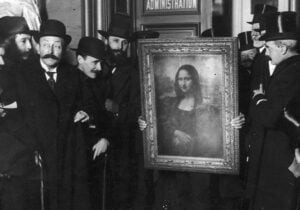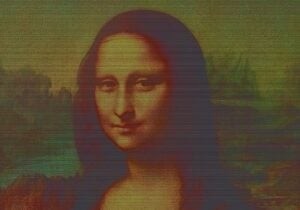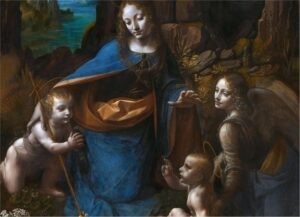
views
Incredible Discoveries Change Experts' View of Mona Lisa
For decades, the enigmatic smile of the Mona Lisa has captivated art historians. Who is she? And why does she wear such a gentle expression? So much about this masterpiece remains a mystery, and perhaps Mona Lisa smiles so enigmatically because Leonardo da Vinci had a secret. At least, that's a theory among experts following a discovery that has reshaped the history of this world-renowned painting.
Her Journey to Fame
Although the Mona Lisa is one of the most famous paintings of all time, there is still uncertainty about the identity of the woman portrayed. Many experts believe she might be Lisa Gherardini, the wife of a merchant from Florence, Italy. However, no documents confirm this commission, leaving the true identity of the Mona Lisa unknown.

Countless individuals have pondered this subject, gazing into the eyes of the painting and studying the delicate smile on her lips. The mystery of her expression remains inexplicable. What is she trying to convey? Thousands of people visit the Louvre in Paris daily, trying to fathom the enigma.
The Man Behind the Woman
One might assume that any painting by da Vinci would attract such attention. Many experts consider him one of the greatest painters of all time, despite there being less than 20 confirmed paintings attributed to him today. Interestingly, new discoveries about the Mona Lisa are altering our understanding of the painter and his work.

Visitors to the Louvre, where the Mona Lisa is displayed, are often surprised by the security measures protecting the portrait. An impressive layer of bulletproof glass shields the artwork. However, its size is less imposing.
Smaller Than Believed
The Mona Lisa measures 30 inches by 21 inches—a modest size when compared to other works by da Vinci. For instance, "The Last Supper" spans an impressive 15 feet in height and 30 feet in width. Nevertheless, the unassuming Mona Lisa has left a profound impact on art history.

Many questions about the Mona Lisa remain unanswered. For instance, the exact time when da Vinci painted it is still unclear. Some say he began around 1503 or 1504. The Louvre itself believes he worked on the project between 1503 and 1506. However, experts have pointed out details suggesting a later date.
Uncertain Origins
Italian historian and da Vinci expert, Carlo Pedretti, argued that the Mona Lisa couldn't have been painted so early. Instead, he believed the style matched that of a Renaissance painter whom da Vinci followed later in his life. For Pedretti, it is clear that da Vinci could not have started this portrait before 1513.

It is also possible that da Vinci used later years to perfect the Mona Lisa, displaying his more mature technique in the painting. Towards the end of his life, he accepted an invitation from King Francis to move to France and work there. It is believed he might have brought the Mona Lisa with him and completed it there between 1516 and 1517.
The Royal Collection
This theory gains weight considering that the Mona Lisa remained in France after da Vinci's death in 1519. He had joined the court of King Francis I, and the monarch retained the portrait in his royal collection. Interestingly, it is said that the Mona Lisa even hung in Napoleon's bedroom during his reign as Emperor of France.

The Mona Lisa found its way to the Louvre at the beginning of the 19th century. As more people visited the portrait, the question of her identity became a topic of great interest. Some experts believe they can confidently answer this question now.
According to many specialists, the Mona Lisa was a Florentine housewife named Lisa Gherardini, who served as Leonardo da Vinci's inspiration for the iconic painting. Although not much is known about her life, some facts have been established. She married Francesco di Bartolomeo di Zanobi del Giocondo at the young age of 15. Her family did not provide a significant dowry, indicating that their marriage was likely based on love.

Their life together brought forth five children: Piero, Camilla, Andrea, Giocondo, and Marietta. In 1503, they moved into their own home, which is believed to be the year da Vinci started working on the portrait. Commissioning the painting may have been part of the celebration of their new house and the birth of their son, Andrea.
Last Will and TestamentIn 1537, Francesco del Giocondo passed away, leaving everything to his wife in his will. He returned her dowry, along with jewelry and clothes. According to the 2006 book "Mona Lisa Revealed" by Giuseppe Pallanti, del Giocondo referred to his wife as "Mona Lisa, my beloved wife."

At that time, Giocondo's family could not have foreseen the influence the portrait would have or the waves it would make in art history. Many people believe that da Vinci embodies the epitome of the "Renaissance Man," someone with extraordinary interests and boundless curiosity. Indeed, da Vinci excelled in multiple fields, including mathematics, engineering, anatomy, architecture, botany, sculpture, and paleontology.
Unbelievable ArtworksDa Vinci became most famous for his work as an artist. He produced around 20 paintings, of which 15 are still in existence today. The masterpieces that have stood the test of time are logically worth a considerable amount of money. In November 2017, his painting "Salvator Mundi" was sold at auction for a staggering $450.3 million!

However, this sum pales in comparison to the Mona Lisa. The painting holds the Guinness World Record for the most expensive insurance. In 1962, it was insured for $100 million. Today, the insurance coverage stands at $852 million.
Making HeadlinesAll these factors—the fascination with the Mona Lisa, da Vinci's place in history, and the painting's value—explain why new information about the portrait continues to make headlines. In this context, the Mona Lisa Foundation, a nonprofit research group, made an astonishing revelation in 2012. Based on X-rays, infrared, and digital scans analysis, the organization concluded that da Vinci had painted more than one image of the housewife. Yes, more than one Mona Lisa!

A second painting is known as the Isleworth Mona Lisa, and it is also believed to be the work of da Vinci. For a century, this artwork hung in a villa in Somerset, England. An English art collector and connoisseur named Hugh Blaker visited the estate before World War II.
Something SpecialThe original owner had purchased the painting in Italy, enchanted by the tranquility of da Vinci's original. When Blaker saw it about 100 years later, he recognized it as something special. The collector acquired it and transported it to his home in Isleworth, West London.

Blaker's stepfather, John R. Eyre, supported the theory that it must be an original. Eyre conducted a study on the artwork and ultimately concluded that the Renaissance artist must have painted two portraits of Gherardini. He claimed that the Isleworth version was the first of the two.
Remaining in ObscurityHowever, the theories of Blaker, Eyre, and Pulitzer about the Isleworth Mona Lisa never gained widespread acceptance among many experts. Moreover, Pulitzer's death in 1979 caused the painting to be forgotten, locked away in a bank in Switzerland for almost 30 years. In 2008, the painting finally emerged from storage, and the research to uncover the truth began.

When the Isleworth Mona Lisa saw the light of day again, the Mona Lisa Foundation was established to verify the claims that da Vinci had painted it. According to the BBC, Vice President David Feldman stated that the organization "has no stake in the painting." Therefore, they strive to examine the facts in the most objective light possible.
Historical SourcesTo determine whether the Isleworth Mona Lisa was an original, the foundation first relied on historical sources. On occasion, da Vinci created multiple versions of the same subject. Perhaps the most famous example is his two copies of the Madonna of the Rocks. One is exhibited in the Louvre, and the other hangs in the National Gallery in London.

Additionally, the foundation considered the drawing of the Mona Lisa made by the renowned artist Raphael. He sketched his own version of the Mona Lisa from memory after seeing da Vinci's work around 1505. Raphael's drawing includes pillars, the pedestals of which are present in the more famous Mona Lisa. However, in the Isleworth version, the pedestals are fully visible.
Showing Her AgeAnother noteworthy aspect is that Gherardini herself appears younger in the unconfirmed portrait. It is possible that del Giocondo commissioned the first version in 1503, while another patron named Giuliano de' Medici requested the second version a decade later. This would explain the apparent age difference between the two women.

Furthermore, John Asmus, a researcher in physics at the University of California, supported the assumption of two versions of this famous painting. According to Feldman of the Mona Lisa Foundation, the results of Asmus's work, which was reviewed by experts, are nearly one hundred percent certain. Regarding this research, Feldman concluded, "The same artist painted at least the face of both the Isleworth and Louvre Mona Lisas."
Not Entirely ConvincedBy making this claim, Feldman asserted, "If you deny that the Isleworth is by Leonardo, you're denying that the Louvre version is." However, not all experts are convinced that both paintings are the work of the Renaissance artist. The Mona Lisa Foundation itself has been questioned regarding its intentions to claim the painting as authentic.

For one, the composition of the Mona Lisa Foundation's board in 2015 was, to say the least, questionable. Feldman neither confirmed nor denied whether those who purchased the Isleworth Mona Lisa sat on the organization's board. He also did not respond to whether the buyers hoped to sell their acquisition as a genuine da Vinci painting.
The Wrong MaterialsAnother questionable detail of the Isleworth Mona Lisa was that the artist painted it on canvas. When da Vinci created art, he generally applied his oil paints to wood, not fabric. This was especially true in the later part of his career when he perfected his technique. While he did use linen canvas quite early on, it was a rare choice for the artist.

Martin Kemp, a professor of art history at the University of Oxford, was one of the loudest voices against the Mona Lisa Foundation's findings. He said that the organization used infrared technology to uncover underdrawings beneath the surface of the Isleworth Mona Lisa, purportedly proving its authenticity. However, the professor countered that these markings did not match the artist's typical preparatory practices.
Not Worth His TimeIn fact, Kemp was certain that the Isleworth Mona Lisa could not be an original by da Vinci, so he never visited it. He explained, "I didn't see anything that was so convincing that I would go to see it myself. I get sent things not by Leonardo about once a week. I have to make choices."

Two different judgments were made about the Isleworth Mona Lisa. Meanwhile, da Vinci's potential has been seen around the world, with his works being flown to exhibitions everywhere—from Singapore in 2014 to Shanghai in 2016 and back to his origin in Florence, Italy.
The exhibition in Florence took place at Palazzo Bastogi and marked the first exhibition in Europe of the Isleworth Mona Lisa in the 21st century. The exhibition concluded with a sensational revelation when an unnamed individual claimed unexpected ownership rights to 25 percent of the painting.

This unnamed individual came from a "respected European family," as stated by their representative lawyer to CNN. Although the legal expert, Giovanni Battista Protti, was willing to speak with CNN, he refrained from disclosing the name of the person or persons behind the claim. However, he revealed that the previous owner of the Isleworth Mona Lisa had sold a quarter of the shares to his client.
Asserting OwnershipThe person demanded part of the ownership to prevent the Isleworth Mona Lisa from ending up in a vault again. Through Protti, they asked the Italian courts to take possession of the potential da Vinci until they could verify their ownership claim. Nonetheless, the Mona Lisa Foundation dismissed the family's claims and vowed to appear in court as well.

It appeared that this family did not wish to create a major drama. Protti stated, "As the owners of the painting, they wanted to make the picture available to the public. When you own such art, you have to behave properly."
Value for the PeopleThe same argument could be made for the analysis of the Isleworth Mona Lisa. Perhaps experts will never definitively determine whether it is a Da Vinci original or not. But as Protti mentioned regarding the exhibition of the painting, "It is not a matter of money. It is just a matter of patience, something that needs to be done. It has a value not only for individuals but also for humanity."

Secrets of da Vinci's works remain partially uncovered to this day. In 2019, an expert group made an astounding discovery beneath the canvas of "The Virgin of the Rocks" painting. The art world was completely surprised.
Two VersionsThis painting depicts Jesus Christ and his mother Mary, with two angels and John the Baptist. As mentioned earlier, the older version is currently displayed in the Louvre Museum, while the second version is exhibited in the National Gallery in London.

Interestingly, a discovery about the latter painting was made in 2005. Experts from the National Gallery found an alternative composition of the Virgin beneath the surface of the painting. Then, about 14 years later, a more significant change came to light, thanks to a research project.
In 2005, a group of researchers made a stunning discovery beneath the surface of Leonardo da Vinci's painting "The Virgin of the Rocks." It turned out that there was an alternative composition of the Virgin Mary hidden beneath the visible layer. This incredible find was made using infrared technology, which allowed them to identify some outlines. However, the real surprise came in 2019 when further investigations were initiated.

In the latest research, the team of scientists employed a cutting-edge technology called Macro X-ray Fluorescence. This advanced technique revealed even more of da Vinci's original sketches beneath the artwork. The presence of zinc in the material he used for sketching made this comprehensive analysis possible.
The Discarded DesignThanks to these scans, the experts could now observe additional drawings of Jesus and the angels alongside the original sketch of Mary. A spokesperson from the National Gallery shared insights with "The Guardian" about this discovery. "Why Leonardo abandoned his initial composition remains a mystery," they revealed in August 2019.

The spokesperson continued, "Handprints were also found, presumably from someone smoothing the primer on the panel. It could have been the work of an assistant, but perhaps it was Leonardo himself."
The Significance"Both figures have a higher positioning compared to the completed artwork, with the angel placed further out, gazing down at Jesus," the spokesperson added. Shortly after, Larry Keith, the director of the gallery, shared his reaction to the findings.

In an interview with BBC News in August 2019, Keith expressed what this discovery could mean for understanding da Vinci's artistic process. "The sketches provide a fresh insight into da Vinci's thoughts. It fits into a broader narrative of how we understand him as an artist who constantly changes, adapts, and revises. We already knew parts of the composition, and now we have a deeper understanding of the group arrangement. We can't wait to learn even more about da Vinci's work in the years to come."




















Comments
0 comment